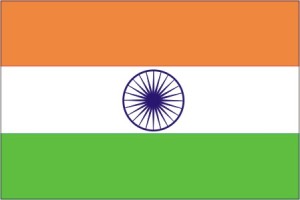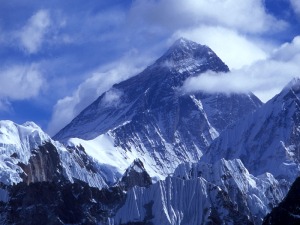Posts Tagged ‘India’

The Indian National Flag
India is one of the oldest civilizations in the world. It is a rough diamond shape with the northern and southern points about 2,000 miles apart.
It has one of the richest cultures in the world, and also very impressive landmarks, such as the Himalayas – the highest and youngest mountains in the world with many peaks rising to more than 20,000 feet. Mt. Everest, the highest mountain in the world, is in the Himalayas and lies partly in India, partly in Nepal and partly in Tibet. Yes, three whole countries.

The stunning Mt. Everest in all its glory
India’s’ namesake is the Indus River, it being life-giving. Archaeologists have uncovered two ancient cities by the Indus River, called Harappa and Mohenjodaro. They were part of what we now call the Indus Valley Civilization, which was at its peak around 2500 B.C. The people in that area were dark-skinned, and known as the Dravidians. They are the earliest known occupants of this area.
Around 1500 B.C., light-skinned Aryans came from central Asia and and conquered all the land around the Indus River, forcing the darker-skinned Dravidians south. Even today, the northern and the southern Indians speak different languages and are lighter and darker skinned respectively.
The Dravidians of ancient Harappa and Mohenjodaro had systems of counting, measuring and writing, and was a considerably developed civilization. Even the cities were laid out in a geometric pattern!
They had indoor baths and toilets, both of which were connected to a sanitary sewage system with drains laid out underneath the roads. The ancient Dravidians were quite advanced in terms of cleanliness, inventing intricate and elaborate bathing systems in a time when soap was merely a distant thought (I’m sure soap was sacred to the sanitary freaks).
People don’t know for certain what it was, exactly, that led the two cities to ruins, but it is thought that serious water problems, such as repeated floods and droughts and the changing course of the river, contributed to wiping out the ancient people. Some historians believe the ancient people quite simply overused and exhausted the land, ruining the soil and effectively causing erosion. The people in the Indus Valley couldn’t survive without the basic necessities that the river provided, and, as a result, they perished.
The Indus Valley Civilization left behind a written language that so far, no one has managed to decrypt. If we manage to one day crack this mysterious language, we’ll probably be able to uncover more about what happened to this ancient civilization.
The Ancient Indian High School Musical-like Food Chain.
As well as kicking out the Dravidians, the Aryans took a society that was already divided tribally, and created a High School Musical-like food chain called castes.
There were four major castes, the highest consisted of the Brahmins, or priests and scholars. Next were the Kshatriyas, or the warriors and rulers. Then came the Vaishyas, or traders and merchants (or the People). Farmers, labourers and servants were the lowest caste, or the Shudras. Hitting rock bottom, were the untouchables—the pariahs or outcasts. They were the people who cleaned the streets, picked up dead animals, and did the other dirty jobs too lowly for anyone else.
However, unlike High School Musical, none of the castes would break out into a song. Ever. (Well, except maybe in Bollywood.)

High School Musical!
Every one of the castes had ironclad rules. A member of one caste could not marry someone in a different caste. Eating a meal with someone from a lower caste, or even eating a meal prepared by someone from a lower caste was unheard of.
And as if the outcasts didn’t have it bad enough, their rules were the strictest. They were supposed to live outside of the village, and not mingle with the other castes. And that was why, they were called the ‘untouchables.’
Today, untouchability has been made forbidden by a law instituted by Mahatma Gandhi, who was one of India’s greatest leaders. While helping to modernise India he kindly renamed the outcasts Harijans or ‘People of God.’
Caste is no longer as influential as it once was, especially in the major Indian cities. But in the many villages scattered around India, caste is still an important part of life. In the villages life goes on just as it did hundreds of years ago and time stands still.